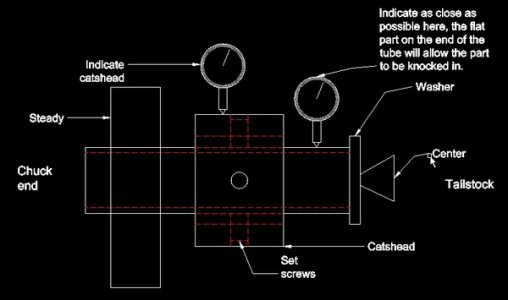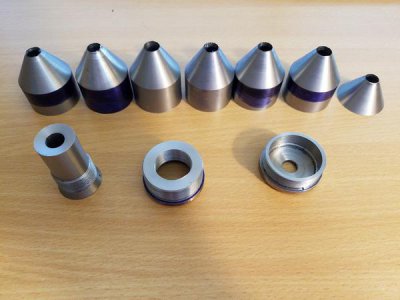I will give you a step by step description of the process, I do not have the inclination to make a video and if I tried would probably get fired for showing Customer parts. With an illustration however.
Steps
1 Place steady on ways well towards the chuck
2 Place part in chuck through steady, if worried about marring the part with the hard jaws buy some cheap aluminum flashing that may be cut with scissors from Home Depot and wrap a few layers around it, you are using a 4 jaw.
3 Indicate the part at the chuck
4 Place a flat something with a hole against the end and apply the center with little pressure at this time, it does not matter if the end is saw cut and not square as this is not what you are measuring. Indicate this end and knock it into the least run out that you can get with a bit of wood or plastic, and a hammer if it is a large heavy part, you may want to indicate at the chuck again but I mostly find this unneeded if the work at the TS end is short
5 Once minimum run out is gained tighten the TS quill on the part and lock it
6 Either cut a band for the steady (even without a plug the tail stock will hold the part for the light cut that a band requires), if this is prohibited install a cats head and indicate as close a possible using the 4 set screws that you cleverly installed just like a 4 jaw chuck, place some of that cheap flashing under the set screws so as not to mar the finish
7 Move steady into position and set the fingers or rollers gently, I have only used steadies with bearing rollers for the last 25 years I rotate the spindle until the rollers begin to rotate.
8 remove TS
9 Face, turn and thread
The chips will not roll under the solid fingers, when running a steady on a finished surface it will leave a mark rollers or fingers, keep that in mind.
This will consume a bit of time but you are a hobbyist and have plenty of that.
I do it for a living and have time quote constraints, could do the above mentioned work in 20-30 minuites on 1 1/2" DOM tubing, however I do not have to obsess over the dimensions, with a few exceptions most of the +2" tube parts that I make have -.005 +.000 if an inside part and +.000 - .002 if a bearing bore.
Good luck





